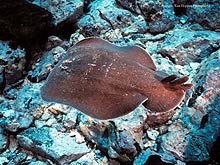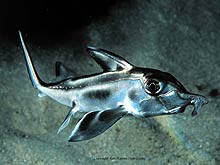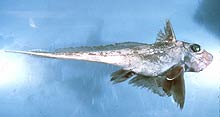The eyes and spiracles are usually on top of the head. The eyes are covered with skin and are indistinct in a few blind electric rays.
More than half the living species of rays have maximum sizes exceeding 50 cm in length. The smallest ray is a shortnose electric ray with a maximum length of 10 cm. The largest ray recorded – the wide sawfish – is 7.6 metres total length, and the largest manta ray recorded is 6.7 metres.
Most ray species prey on invertebrates and small fish, but some are plankton feeders, such as manta rays. Most rays are bottom dwellers and feed by trapping prey with their disc against the substrate.
Features used for identifying species of rays are colour, disc and tail shape, nasal and mouth structure, distribution, and shape of dermal thorns and denticles. Taxonomically, rays form a single broad group called Batoidea, within which there are 16 families of living rays. |

Coffin Ray
(© Ken Hoppen, oceannotions@primus.com.au) |
Chimaeras
Chimaeras are different from sharks and rays in a number of ways:
- The upper jaw is fused to the underside of the skull;
- There is only one gill opening;
- The skin is smooth and lacks denticles;
- The teeth are fused into plates that are often beak-shaped;
- The tail is long and narrow.
They range in size from 50 cm to 2 metres total length. All chimaeras lay eggs and feed on invertebrates. They are found mainly on the continental slopes in deep water.
Chimaeras can be identified from colour, head shape, position and shape of the fins, dorsal spines and tooth plate structure. Living chimaeras are classified into three families.
Kate Sputore (Rottnest Island Authority) and Alex Gaut (MESA) adapted this information sheet for children (which is suitable for primary school students) from the information sheet compiled for the general public by © Terence Walker (Terry.Walker@dpi.vic.gov.au).
This information sheet may be copied for educational purposes. For any other purpose please contact your State MESA representative: http://www.mesa.edu.au/council/contacts.asp
|

Juvenile elephant shark (© Ken Hoppen, oceannotions@primus.com.au)

Southern chimaera
(© Terence I. Walker)
|
